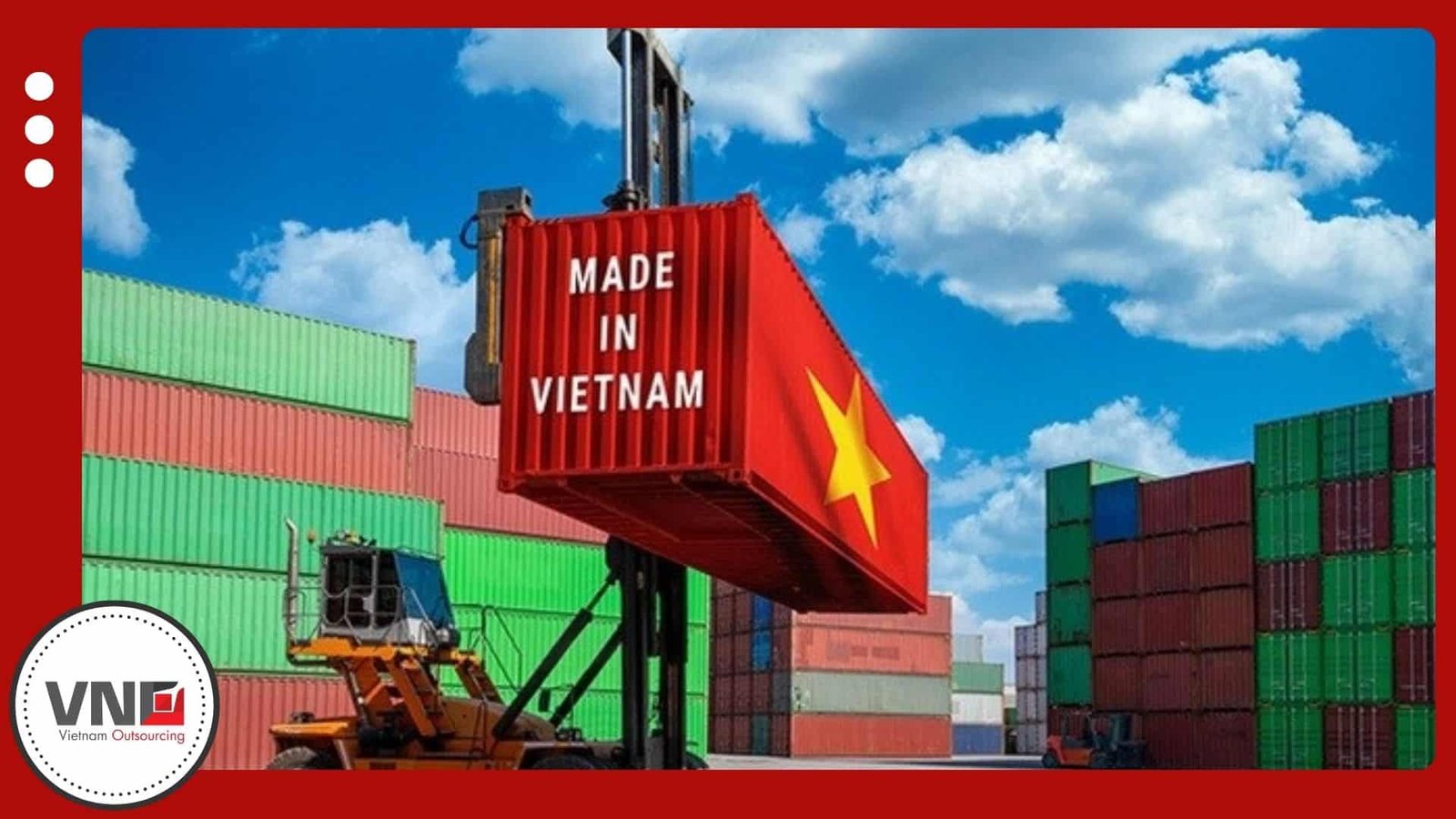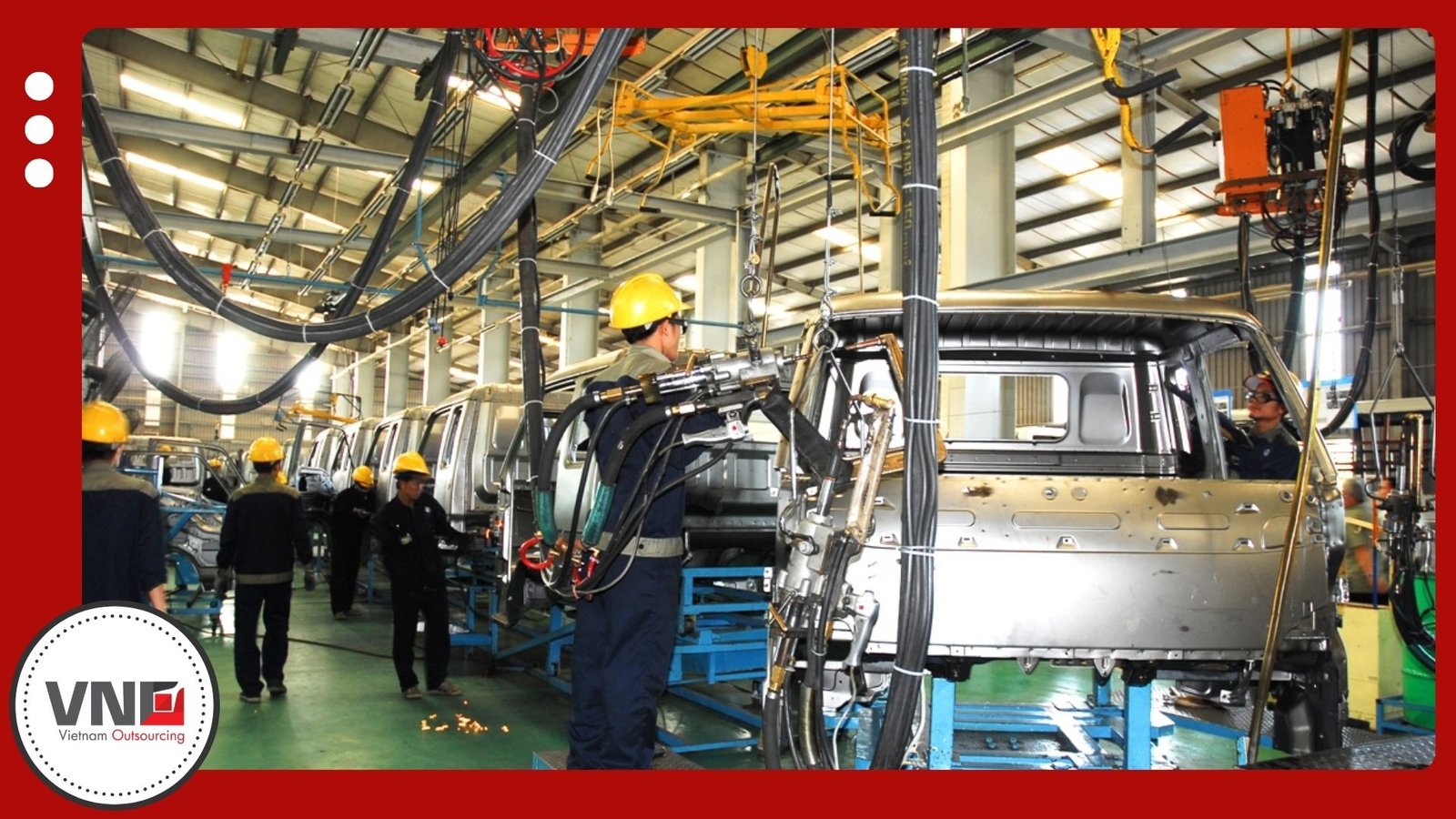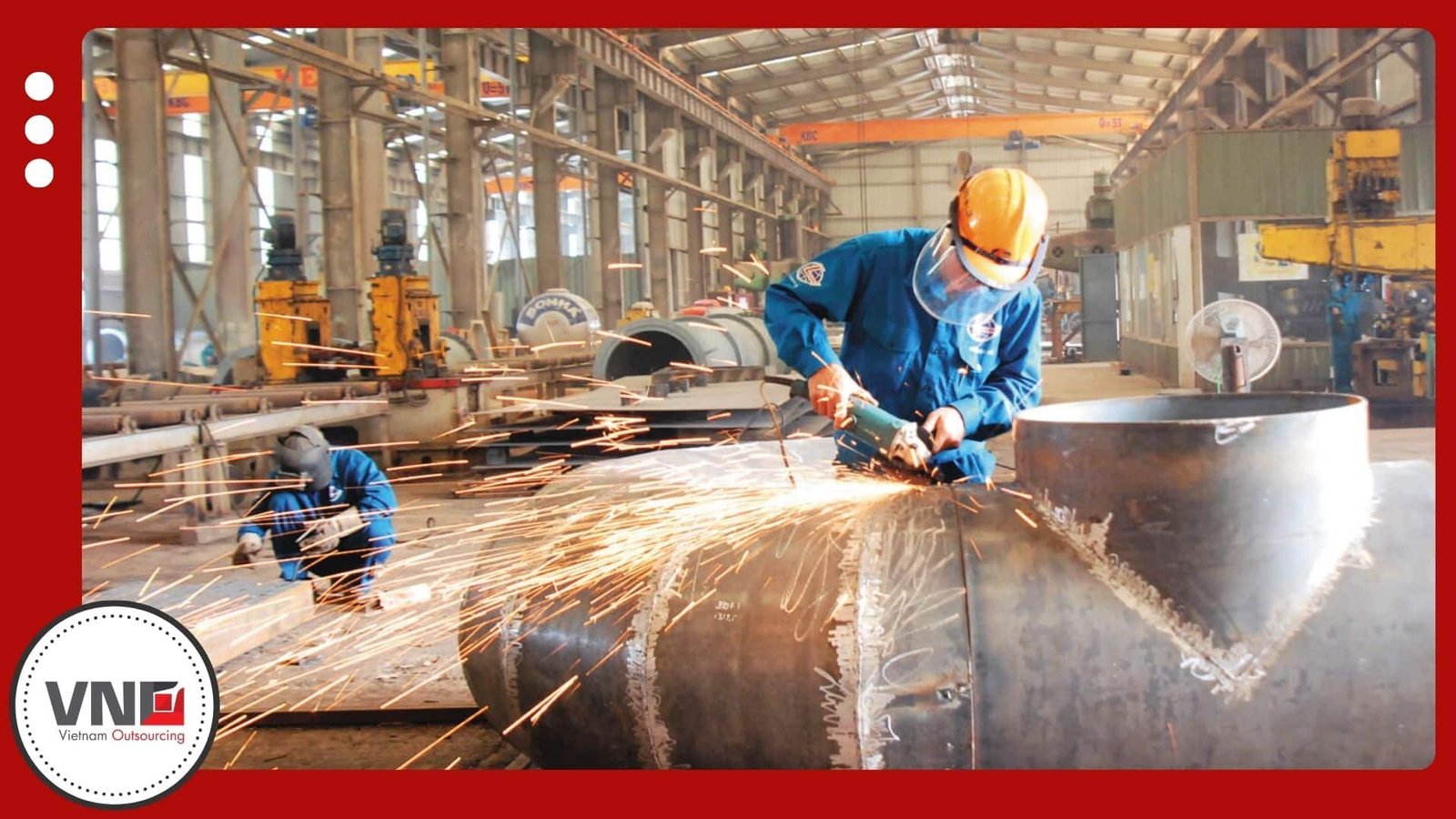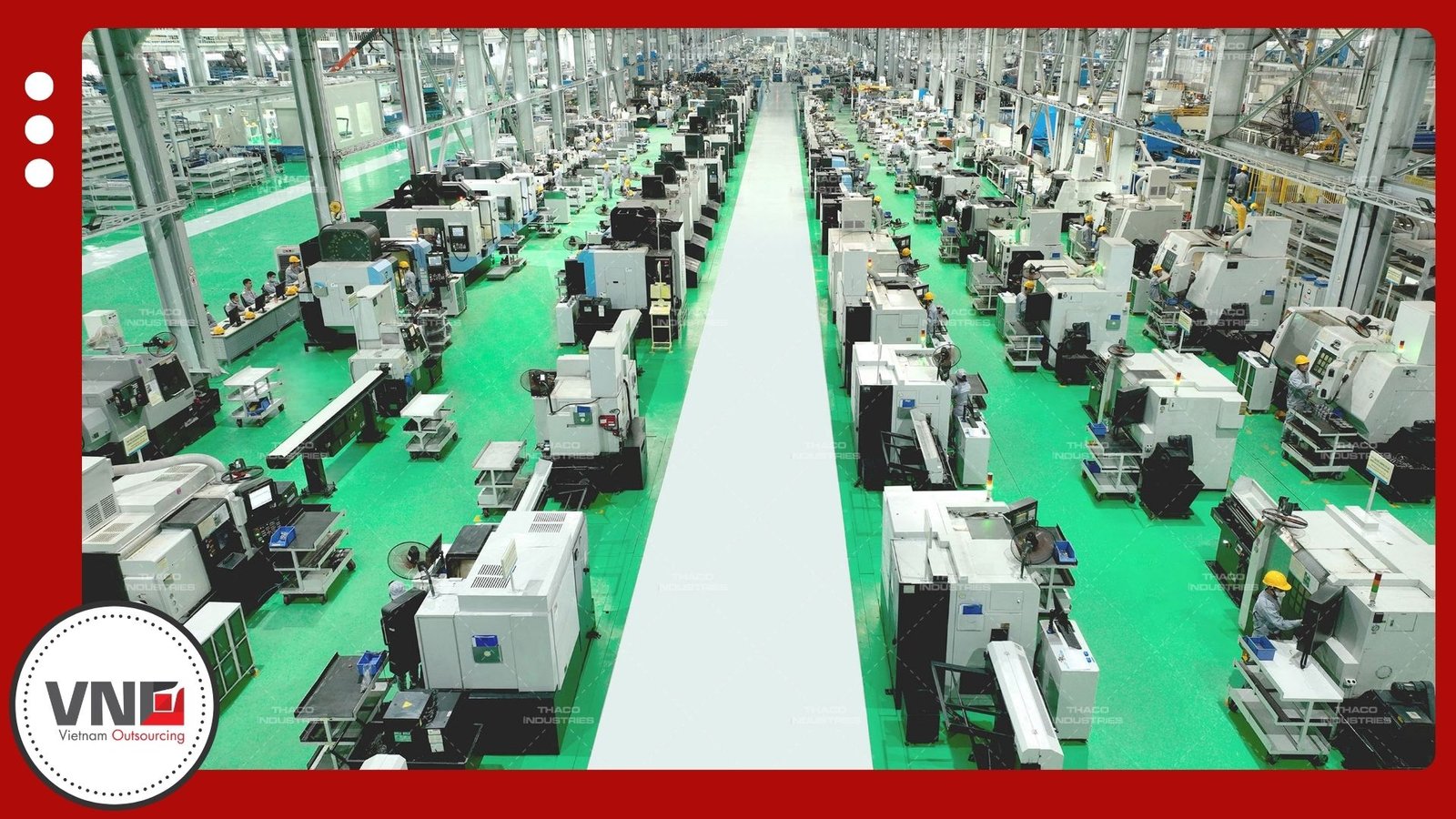
Outsourcing Manufacture in Vietnam 2025–2026
Table of Contents
Introduction
In 2025, global supply chains are changing fast because of tariffs, emissions rules, and new trade patterns. For many companies, outsourcing manufacture in Vietnam has become the smartest strategy. It combines low production costs, a skilled workforce, and direct access to major markets.
Vietnam’s exports already topped $430 billion in the first half of 2025, showing how strong its role in manufacturing has become. As buyers look ahead to 2026, the EU’s CBAM and Vietnam’s own ETS mean that outsourcing to Vietnam requires both cost planning and compliance readiness.
Why Outsourcing Manufacture in Vietnam Matters in 2025–2026
Cost Savings and Labor Advantage
One of the strongest reasons companies are outsourcing manufacture in Vietnam is cost efficiency. For example, the average monthly wage for factory workers is around US$350–400, compared with US$1,200+ in China.
Moreover, Vietnam offers a large, young workforce trained in machining, welding, and electronics. Many vocational schools are linked directly to industrial parks, which creates a steady supply of semi-skilled and skilled labor. As a result, buyers from the U.S. and EU achieve a unique balance of lower costs and rising quality.
Trade Agreements and Tariff Advantages
Vietnam’s appeal goes beyond labor. In addition, the country benefits from multiple free trade agreements, including CPTPP, EVFTA, and RCEP.
- EVFTA has already removed tariffs on thousands of goods, making it easier for European companies to shift procurement.
- CPTPP connects Vietnam with high-value markets such as Canada and Japan.
- RCEP simplifies trade across Asia-Pacific.
Equally important, Vietnam faces no U.S.-imposed tariffs like those targeting China. Therefore, American buyers using Vietnam as a sourcing base avoid the 25–30% duties applied to Chinese products. This gives them both production and import cost advantages.
The “China+1” Strategy
Since 2019, global buyers have accelerated the China+1 strategy. For instance, in 2025 alone, a large share of new foreign investment into Vietnam came from Chinese firms setting up second bases.
However, this does not only expand capacity—it also confirms Vietnam’s strategic role in supply chain diversification. Consequently, U.S. and EU companies now see Vietnam as a hedge against geopolitical risk while still keeping their Asia supply chains efficient.
Government Leadership and Investment Incentives
The Vietnamese government actively attracts Western buyers through:
- Industrial Parks & Free Zones: Over 400 ready-built facilities offer “plug and play” options.
- Tax Incentives: Up to 4 years of corporate tax exemptions plus reductions for priority industries.
- Green Transition Programs: Support for factories to meet environmental standards before CBAM 2026.
- Logistics Upgrades: Ports, highways, and air cargo hubs reduce lead times to the U.S. and Europe.
Therefore, Vietnam is positioning itself not just as a low-cost location but as a policy-driven, sustainability-ready outsourcing hub.
Growing Trust Among Western Buyers
Moreover, Vietnam has earned buyer trust. Multinationals like Samsung, Apple suppliers, Adidas, and leading automotive firms already produce in Vietnam.
This proves the country has the scale, compliance systems, and reliability needed for complex supply chains. Consequently, outsourcing manufacture in Vietnam has become a mainstream strategy rather than a cost-saving experiment.

Key Manufacturing Capabilities in Vietnam (2025–2026)
Vietnam Metal Fabrication
One of the main reasons companies are outsourcing manufacture in Vietnam is the strength of its metal fabrication industry. The sector provides cutting, welding, bending, and finishing, and is forecast to grow at nearly 7% annually. For deeper insights, read our Vietnam Metal Fabrication: Complete Guide to Outsourcing.
Precision Machining in Vietnam
Vietnam is also becoming a preferred location for outsourcing manufacture of precision-machined parts. With advanced CNC shops delivering aerospace-level tolerances, more buyers are now shifting projects here. See our guide to Precision Machining in Vietnam.
Vietnam Die Casting Supplier Network
Die casting is another capability that makes outsourcing manufacture in Vietnam attractive. Many suppliers now integrate casting, machining, and finishing into one streamlined process. Learn more in our Vietnam Die Casting Supplier: Industry Outlook 2025.
Metal Forming Outsourcing
For stamping, forging, and deep drawing, Vietnam offers competitive pricing and skilled operators. Because of this, outsourcing manufacturing to Vietnam has become a good choice for automotive and heavy machinery firms. Read more in our Metal Forming Outsourcing in Vietnam analysis.
Aluminum Manufacturing in Vietnam
Another fast-growing capability is aluminum extrusion and finishing. EV and aerospace companies increasingly rely on Vietnam manufacturing outsourcing for lightweight parts. More details are in our Aluminum Manufacturing in Vietnam.

Compliance & Supply Chain in Vietnam 2025–2026
When outsourcing manufacture in Vietnam, buyers must plan for new compliance rules. From January 2026, the EU’s CBAM will require emissions reporting for aluminum, steel, and other imports.
Vietnam’s ETS, launched in 2025, adds local carbon reporting. Therefore, buyers need suppliers who can meet ISO, ASTM, and IATF standards. See our Compliance & Supply Chain in Vietnam 2025 Guide for best practices.
Challenges and Risk Mitigation
There are risks in outsourcing manufacture in Vietnam:
- Quality gaps among smaller suppliers
- Limited advanced engineering in some industries
- Rising logistics costs
- Tariff-related policy risks
However, these can be managed with supplier audits, pilot runs, third-party inspections, and early emissions planning.
Market Outlook 2025–2026
Macro & demand backdrop.
Vietnam’s industrial momentum remains strong heading into 2026. In the first half of 2025, exports exceeded $430 billion and manufacturing output grew at double-digit rates. Overall GDP growth is expected to remain in the 6.5–7% range, driven largely by exports and industrial production.
Fabrication & structural steel
Buyers should expect steady demand for structural assemblies, welded fabrications, and steel components. The structural steel fabrication segment alone is valued at over $3 billion in 2025 and projected to grow at nearly 8% annually through 2030. This growth is supported by automation investments and ongoing infrastructure expansion.
Aluminum components & extrusions.
Aluminum is a critical growth area, driven by global demand from EV platforms, battery casings, and aerospace applications. Vietnam’s aluminum industry is forecast to grow 6–8% annually through 2030, with exports steadily rising. Higher export unit prices also signal a shift toward higher-value aluminum parts and improved margins.
Die casting (Al/Zn)
The die casting industry continues to expand, especially for EV drivetrains, housings, and thermal management components. More suppliers are now integrating casting, machining, and finishing into single operations, which reduces lead times and strengthens quality control for international buyers.
Precision machining.
Multi-axis CNC adoption and in-process metrology are allowing Vietnam to capture more mid- to high-precision work across electronics, robotics, and mobility sectors. Larger groups are consolidating smaller machine shops, creating more reliable partners that can manage entire production programs with consistent quality systems.
Policy & tariffs—watch-outs.
While growth remains strong, procurement teams must monitor tariff risks. Vietnam has introduced its own anti-dumping duties on certain steel imports to stabilize local supply, while U.S. and EU regulators continue to scrutinize rules of origin. Documentation, compliance, and diversified sourcing strategies will be key in 2026.
CBAM & carbon costs.
Starting January 2026, the EU will require importers of steel and aluminum to purchase CBAM certificates tied to carbon emissions. This will increase costs for non-compliant suppliers. Buyers should prioritize Vietnamese partners who can document low-carbon inputs, renewable energy use, and traceability across the supply chain.
Logistics & infrastructure.
Vietnam continues to invest in ports, highways, and air cargo facilities. These upgrades reduce bottlenecks and shorten delivery times, though logistics costs can still fluctuate due to regulatory changes. Procurement teams should maintain buffer stocks and dual shipping modes to minimize disruption.
FDI & “China+1” momentum.
Vietnam remains the top destination for companies diversifying away from China. Foreign investors, including major tier-1 suppliers, are establishing or expanding operations in Vietnam to serve U.S. and EU customers. This trend ensures a wider supplier base for outsourcing manufacture in Vietnam and strengthens the country’s position in global supply chains.
What this means for procurement teams.
- Expect consistent growth in fabrication and aluminum demand through 2026–2030.
- Choose partners that can prove compliance and provide CBAM-ready reporting.
- Favor suppliers offering integrated solutions—casting, machining, and finishing under one roof.
- Keep a tariff and origin compliance playbook ready to respond quickly to policy shifts.
The 2025–2026 outlook is strongly positive for metal procurement in Vietnam. Growth across fabrication, machining, die casting, and aluminum is supported by industrial demand and foreign investment. However, compliance with carbon reporting and trade rules will increasingly separate the most reliable suppliers from the rest.

How to Outsource Manufacture to Vietnam
- Define technical and compliance requirements.
- Vet suppliers with audits and references.
- Negotiate contracts covering QA and emissions data.
- Run pilot tests before scaling.
- Scale production with KPIs and audits.
- Prepare now for CBAM 2026.
Conclusion
As global supply chains transform, outsourcing manufacture in Vietnam stands out as both a cost-saving strategy and a long-term investment in resilience. Vietnam combines affordable labor with a skilled workforce, broad trade agreements, and government-backed incentives that directly support international buyers.
Moreover, the country’s growing role in the China+1 strategy shows that Vietnam is not just a backup option, but an emerging leader in Asia’s industrial landscape. With infrastructure upgrades, sustainability programs, and compliance readiness for CBAM 2026, Vietnam is aligning itself with the needs of Western companies seeking reliable and responsible partners.
Therefore, businesses that act now can secure a strong foothold in a market that is rapidly becoming a global manufacturing powerhouse. By partnering with trusted outsourcing experts, buyers gain access to Vietnam’s metal fabrication, precision machining, die casting, aluminum production, and forming industries—all while reducing risks and staying compliant.
Looking for a reliable outsourcing partner? Contact VNO today to discuss your project and unlock the benefits of outsourcing manufacture in Vietnam.
Get ahead with forward-looking Vietnam Manufacturing News and Insights for 2025–2026, revealing how sustainability, automation, and trade policies will redefine global outsourcing to Vietnam.
FAQ Section
Because it combines lower costs, strong trade agreements, and growing industrial capabilities.
Automotive, aerospace, renewable energy, electronics, and heavy machinery all benefit.
Vietnam is cheaper, more reliable for delivery, and better aligned with EU/US compliance.
The EU’s CBAM (2026), Vietnam’s ETS, and meeting ISO/IATF standards.
Standard lead times range from 6–12 weeks, with longer cycles for tooling and audits.

